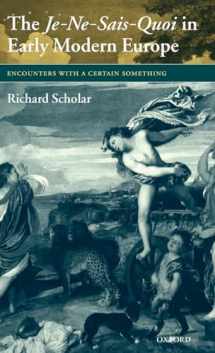
The Je-Ne-Sais-Quoi in Early Modern Europe: Encounters with a Certain Something
ISBN-13:
9780199274406
ISBN-10:
0199274401
Edition:
1
Author:
Richard Scholar
Publication date:
2005
Publisher:
Oxford University Press
Format:
Hardcover
352 pages
FREE US shipping
Book details
ISBN-13:
9780199274406
ISBN-10:
0199274401
Edition:
1
Author:
Richard Scholar
Publication date:
2005
Publisher:
Oxford University Press
Format:
Hardcover
352 pages
Summary
The Je-Ne-Sais-Quoi in Early Modern Europe: Encounters with a Certain Something (ISBN-13: 9780199274406 and ISBN-10: 0199274401), written by authors
Richard Scholar, was published by Oxford University Press in 2005.
With an overall rating of 3.6 stars, it's a notable title among other
books. You can easily purchase or rent The Je-Ne-Sais-Quoi in Early Modern Europe: Encounters with a Certain Something (Hardcover) from BooksRun,
along with many other new and used
books
and textbooks.
And, if you're looking to sell your copy, our current buyback offer is $0.3.
Description
What is the je-ne-sais-quoi, if it is indeed something at all, and how can it be put into words? In addressing these questions, Richard Scholar offers the first full-length study of the je-ne-sais-quoi and its fortunes in early modern Europe. He examines the expression's rise and fall as a noun and as a topic of philosophical and literary debate, its cluster of meanings, and the scattered traces of its "pre-history." Placing major writers of the period such as Montaigne, Shakespeare, Descartes, Corneille, and Pascal alongside some of their lesser-known contemporaries, Scholar argues that the je-ne-sais-quoi serves above all to trace a series of first-person encounters with a certain something as difficult to explain as its effects are intense, and which can be expressed only by being expressed differently. He shows how the je-ne-sais-quoi comes to express that certain something in the early modern period, and suggests that it remains capable of doing so today.


We would LOVE it if you could help us and other readers by reviewing the book
Book review

Congratulations! We have received your book review.
{user}
{createdAt}
by {truncated_author}


